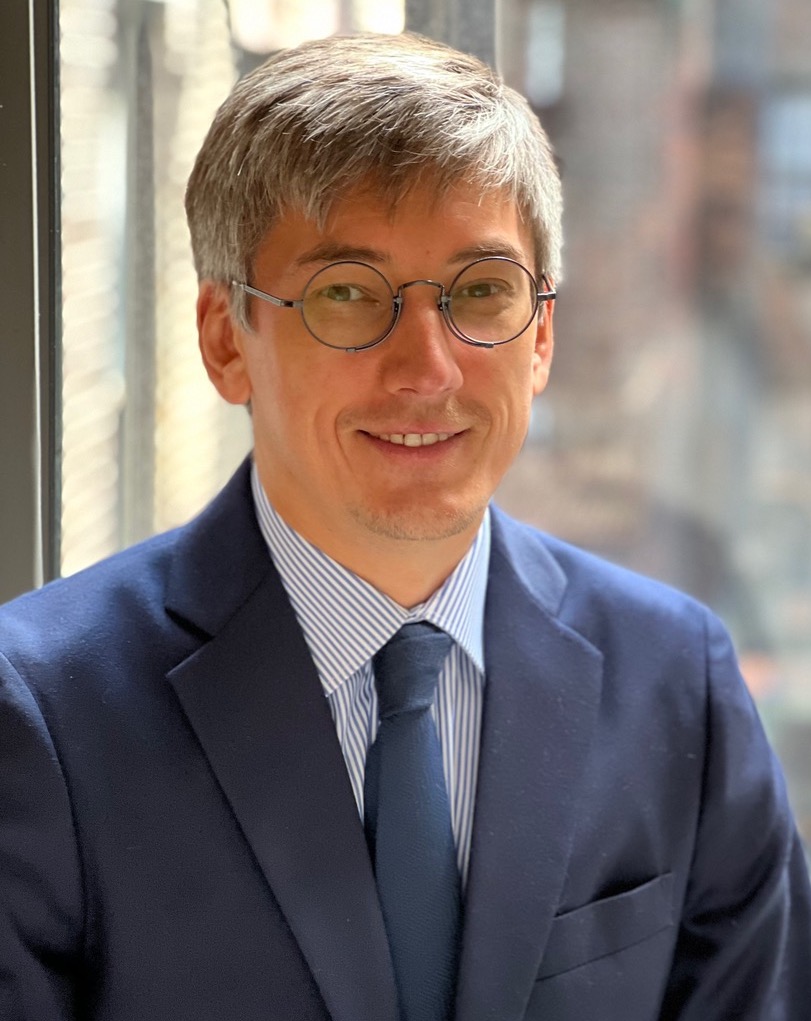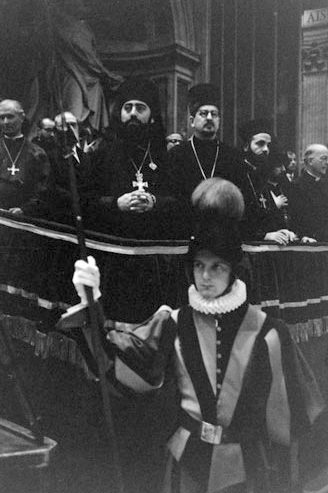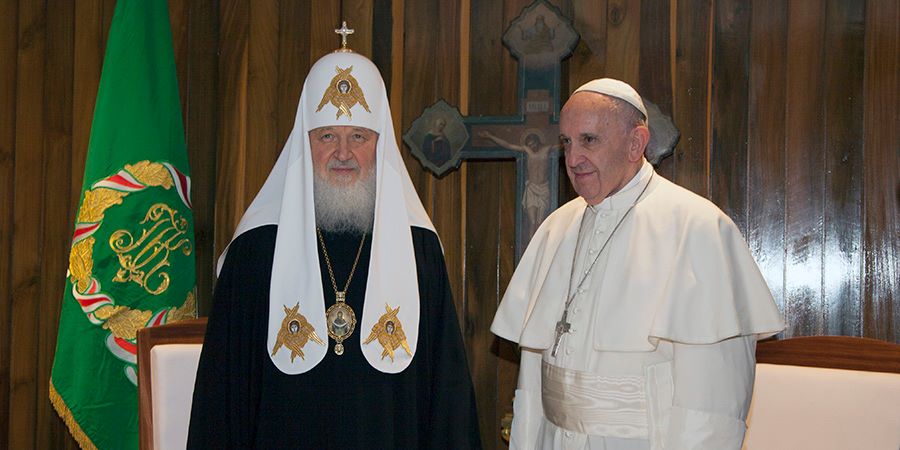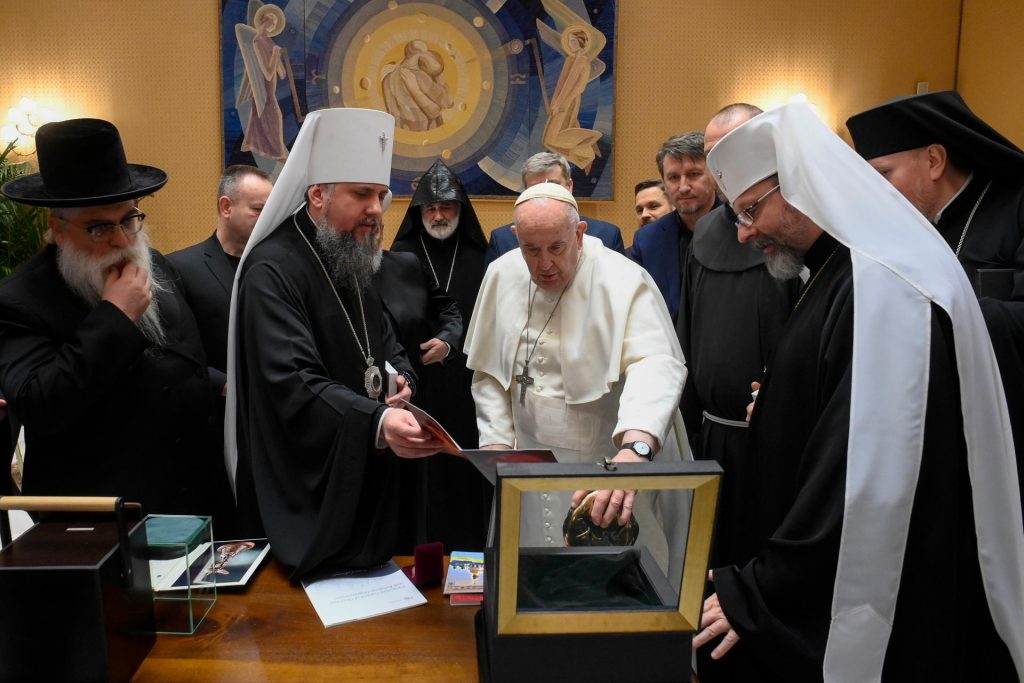
Pavlo Smytsnyuk is a Mary Seeger O’Boyle Associate Research Scholar at Princeton University.
The Russia-Ukraine war has posed a significant challenge to relations between the Holy See and the Russian Orthodox Church (ROC). Although the Vatican’s position on the war has been criticized by some as ambiguous and overly neutral, certain war-related comments by Catholic leadership have been interpreted negatively by the ROC. The Pope’s warning that Kirill must not serve as Putin’s “altar boy” was followed by an accusation by Cardinal Kurt Koch (Prefect of the Dicastery for Promoting Christian Unity, the main Vatican body on inter-confessional relations) that the ROC was in a state of “heresy,” in light of its justification for the war in Ukraine.
Yet the ROC over the past 70 years has invested a great deal in its relationship with the Catholic Church. During the 1960s, the ROC sent its observers to the Second Vatican Council—arguably the most important event in the history of contemporary Catholicism.

One reason the ROC desired to be engaged in dialogue with the Catholic Church was to undermine the Patriarchate of Constantinople in its efforts to present itself as a leader of the Orthodox community of churches. The Ecumenical Patriarch of the time, Athenagoras, spent years in the United States and was seen as dangerously pro-American. Moreover, prior to its agreement to send representatives, the ROC (in particular, Metropolitan Nikodim Rotov, the mentor to the current Patriarch, Kirill of Moscow) searched for assurances from John XXIII’s Curia that the Council would not engage in condemning communism.
As on many similar ecumenical occasions, the ROC’s observers were accompanied to Rome by KGB agents. Ukrainian Greek Catholic bishops from the diaspora protested against the presence of ROC representatives, to the dismay of Vatican officials. At the same time, contacts between the Catholic Church and the ROC, inaugurated on the eve of the Council, as well as the physical presence of the observers in Rome, facilitated the 1963 release of Metropolitan Josyf Slipyi, the leader of Ukrainian Greek Catholics, from an almost two-decades-long Siberian imprisonment.
I would suggest that the key dynamics in the relationship between the Catholic and Russian Orthodox Churches have remained unaltered since the 1960s.
First, the ROC’s interest in ecumenism is deeply permeated with a political rationale. On the one hand, Moscow uses relations with Rome to counteract Constantinople’s leadership within Orthodoxy. While in the mid-twentieth century Stalin wanted to make Moscow the center of World Orthodoxy, the contemporary ROC, having broken communion with the Phanar,[1] positions itself as a leader of conservative Orthodoxy. The 2016 Havana meeting between Francis and Kirill can be seen as a counterweight to the Pan-Orthodox Council meeting in Crete, convened by Constantinople and boycotted by Moscow and some other churches.

On the other hand, the ROC provides faith-based support for the Kremlin’s geopolitical agenda. Before the fall of the iron curtain, the ROC amplified the Kremlin’s “fight for peace” efforts and helped cleanse the regime’s bad reputation related to violations of religious freedom and other human rights; today, the Patriarchate helps garner support for Russian policies among conservative Catholics and, through this, attempts to bring Russia out of isolation.
The Havana meeting has been read as an effort to raise support for Russia’s intervention in Syria. Similarly, Pope Francis’s initial reactions to the Russian invasion of Ukraine have been interpreted in Russia as the result of successful diplomacy by the ROC and Patriarch Kirill. Successes of this sort might be among the reasons why the Moscow Patriarchate pursues dialogue with the Catholic Church notwithstanding severe criticism coming from its base and some clergy—probably even more today than in the 1960s.
At the same time, the ROC’s interest in ecumenism cannot be reduced to secular politics narrowly understood. During the Soviet period, relations with the Churches in the West were also a way for the ROC to increase its international visibility and thus to defend its temples and monasteries from being shut down by the government. Today, ecumenical relations help the ROC demonstrate its utility to the government and thus have privileged access to the Russian public.
Second, for the Holy See, relations with the ROC come with a price, which implies being silent on issues to which Moscow is particularly sensitive. The situation is further complicated by the fact that the Rome on the Tiber is caught in the struggle over Orthodox leadership between the New Rome (Constantinople) and the Third Rome (Moscow).
For example, following Constantinople’s declaration of intent to resolve the schism within Ukrainian Orthodoxy, the ROC decided to suspend its participation in all bodies and meetings chaired or co-chaired by Constantinople. This has put into jeopardy the official dialogue between the Catholic and Orthodox churches, which now lacks wider representation and thus the authority to build a consensus on important theological issues. This instrument for communicating and building and maintaining relations, which was meticulously crafted over the past 50 years, is now significantly undermined.
Another area where tensions between Constantinople and Moscow influence the Vatican’s decision-making is in the Vatican’s relationship with Ukrainian Orthodoxy. Rome’s attempts to maintain neutrality between two major ecclesial powers have translated into it avoiding building a relationship with the newly created Orthodox Church of Ukraine. (In January 2023, Pope Francis met the new Church’s leader, Epiphany. However, he did this in Epiphany’s capacity as a member of a delegation of Ukrainian faith leaders and not as the head of an autocephalous Orthodox church.) As a result, the Holy See has ignored one of the most important religious communities in Ukraine (and one of the biggest Orthodox churches in Europe), which undermines its influence and reputation in Ukraine.

Similarly, Ukrainian Greek Catholics feel that the Holy See under Francis has returned to the policy of Ostpolitik practiced by John XXIII and Paul VI. Friendly relations with the Vatican helped Moscow to claim the (ex-)Soviet Union as its “canonical territory,” thus slowing the development of Catholic structures in the region. In the meantime, the Greek Catholic demand to be elevated to the status of Patriarchate remains unanswered. The voice of Ukrainian Greek Catholic leader Sviatoslav Shevchuk—critical of the Vatican on a variety of issues, from the Havana Declaration to the Pope’s approach on the war to same-sex blessings—echoes that of his predecessor, Josyf Slipyi, who was in constant tension with the Vatican over the rights of his church. In both cases, the Holy See has paid a high price in terms of its moral credibility.
Third, the Holy See believes, today as it did 70 years ago, that through dialogue and concessions to the ROC it might advance some of its interests: both religious (the unity of Christians) and humanistic (since the contemporary Papacy sees itself as a promotor of peace and humanity worldwide).
Although Francis, coming from Latin America, views both the Church and geopolitics from a different perspective than his European predecessors, his interest in ecumenism has been apparent from the very first days of his pontificate. The ROC, as numerically the biggest Eastern Christian church, with influence over many other Orthodox churches, has been seen as a key to the Vatican’s project of Christian unity. Besides, Kirill, who has had more ecumenical exposure than any other incumbent of the Muscovite patriarchal throne, could have been a perfect partner in this endeavor.
Pope Francis, to an even larger extent than John XXIII during the Cuba missile crisis, feels under pressure from the public and media to do something in order to bring the ongoing Russo-Ukrainian war to an end. Like John XXIII, the author of Pacem in Terris (1963), Francis repudiates war and calls on us to reconsider the millennia-old “just war” tradition. Francis wants to be the chaplain of NATO and the West even less than John XXIII did. By keeping the doors for dialogue open with the ROC, he tries to position himself as super partes, accepting the risk of putting his moral credibility in jeopardy.
History will surely show whether this was the right approach, but from the perspective of today, it would be a mistake to read all of Francis’s gaffes as him naively letting himself be exploited by Russia. In line with his predecessors, Francis uses abstract and hortatory language against war, prefers not to “name names,” and usually respects the relative autonomy of the secular sphere. Moreover, Francis pursues his logic built on a Christian conviction that good ultimately triumphs over evil, that everybody, even the most discredited actors, have a ray of God’s light in their conscience. In relation to the ongoing war, this approach has produced almost no fruit. But many other political and religious actors have achieved even less than that.
[1] Editor’s note: Phanar (in Istanbul, Turkey) is both the geographic location of the Ecumenical Patriarchate of Constantinople and a term used to refer to the Patriarchate itself.
